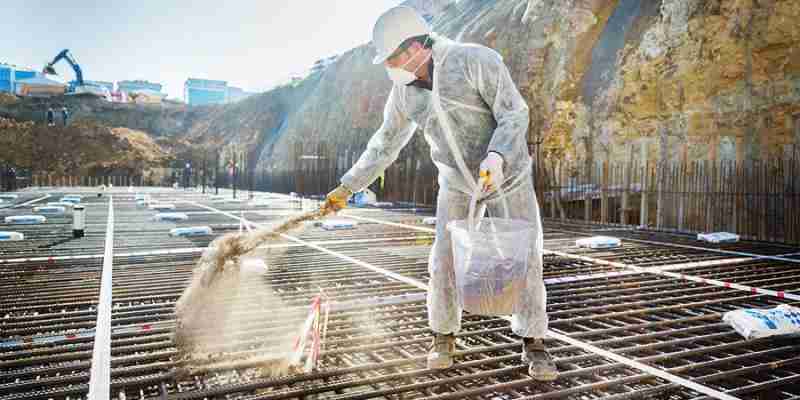The construction chemicals market is undergoing rapid transformation, with innovation playing a pivotal role in shaping the future of construction. As the demand for sustainable, durable, and high-performance building materials continues to rise, new technologies and product innovations are revolutionizing the way construction projects are executed. Innovations in construction chemicals not only improve the quality and performance of construction materials but also contribute to environmental sustainability, cost savings, and safety in construction. This article explores some of the most significant innovations in the construction chemicals market and how they are transforming the industry.

1. Self-Healing Concrete
One of the most groundbreaking innovations in construction chemicals is the development of self-healing concrete. Concrete, a core material in most construction projects, is highly susceptible to cracking due to stress, moisture, and environmental factors. Traditional methods of repairing concrete cracks are labor-intensive and costly, often requiring substantial downtime in construction projects.
Self-healing concrete, however, contains special agents such as microcapsules or bacteria that can automatically repair cracks when they form. These agents release healing compounds (such as calcium carbonate or polymeric materials) into the cracks, allowing the concrete to regenerate its structural integrity without human intervention. The incorporation of self-healing materials enhances the longevity and durability of concrete structures, reducing maintenance costs over time. This innovation not only improves the performance of concrete but also offers a more sustainable and cost-effective approach to managing wear and tear in buildings, roads, and bridges.
2. Green Construction Chemicals
As environmental awareness grows, there is an increasing demand for sustainable construction practices. Green construction chemicals, which include eco-friendly products that have minimal environmental impact, are gaining popularity in the construction industry. These chemicals are designed to reduce the carbon footprint of construction projects, improve energy efficiency, and promote resource conservation.
Low-VOC (volatile organic compound) coatings, adhesives, and sealants are among the most widely used green construction chemicals. VOCs contribute to air pollution and are harmful to both human health and the environment. By developing low-VOC and non-toxic alternatives, manufacturers are helping reduce emissions and enhance indoor air quality in buildings. Furthermore, many green construction chemicals are derived from renewable or recyclable resources, such as bio-based polymers or natural aggregates, reducing the reliance on petroleum-based materials.
The growing adoption of green building certifications, such as LEED (Leadership in Energy and Environmental Design) and BREEAM (Building Research Establishment Environmental Assessment Method), is driving the demand for these sustainable chemicals. As governments and private organizations place greater emphasis on energy-efficient, low-carbon construction, the market for green construction chemicals is expected to grow rapidly in the coming years.
3. Nano-Technology in Construction Chemicals
Nanotechnology has introduced a range of innovative applications in the construction chemicals market. By manipulating materials at the atomic or molecular level, nanotechnology allows the creation of highly specialized chemicals with enhanced properties. Nanomaterials can improve the strength, durability, and resistance of construction materials, offering solutions to common challenges faced in construction.
For example, nanotechnology is being used in concrete admixtures to improve the workability and strength of the material while reducing its environmental impact. Nanoparticles such as silica fume and carbon nanotubes can be added to concrete to increase its tensile strength, improve its resistance to cracking, and enhance its durability against chemical attacks.
Similarly, nano-coatings are being used in construction chemicals to create surfaces that are resistant to corrosion, water, UV radiation, and staining. These coatings not only enhance the lifespan of building materials but also help reduce maintenance costs. Nanotechnology is also improving the performance of waterproofing membranes, making them more efficient at protecting structures from water infiltration, which is especially beneficial in regions with heavy rainfall or high humidity.
4. High-Performance Concrete Admixtures
The development of high-performance concrete admixtures is another major innovation that has reshaped the construction chemicals market. Admixtures are chemical compounds added to concrete during mixing to enhance its properties, such as workability, strength, and durability. High-performance admixtures enable concrete to meet specific requirements, such as greater compressive strength, resistance to chemical attack, and improved freeze-thaw resistance.
Innovative concrete admixtures now include superplasticizers that improve the flowability of concrete without increasing its water content. This leads to stronger and denser concrete, which is essential for high-rise buildings, bridges, and other large infrastructure projects. Additionally, air-entraining agents are being used to improve the freeze-thaw resistance of concrete in regions with extreme weather conditions. The inclusion of fibers, such as steel or glass, further enhances the structural integrity and crack resistance of concrete, contributing to the overall durability and longevity of structures.
5. Smart Coatings and Sensors
Smart coatings are another innovative trend in the construction chemicals market, particularly in the realm of building maintenance and monitoring. Smart coatings can change their properties in response to environmental stimuli, such as temperature, humidity, or light. These coatings can also contain embedded sensors that monitor the condition of structures in real time, providing valuable data for maintenance and repair.
For instance, self-sensing coatings are used to detect cracks or damage in concrete, alerting building managers to potential structural issues before they become critical. Similarly, coatings that respond to UV light or temperature changes can help buildings adapt to environmental conditions, improving energy efficiency and occupant comfort.
The integration of smart sensors with construction chemicals opens up opportunities for predictive maintenance, reducing the need for frequent inspections and costly repairs. The ability to monitor the health of structures remotely also enhances safety by identifying issues early and preventing catastrophic failures.
6. Bio-based Construction Chemicals
The growing demand for sustainability has led to the development of bio-based construction chemicals derived from renewable natural resources. These chemicals are often biodegradable and non-toxic, offering a more environmentally friendly alternative to traditional petroleum-based construction materials.
Bio-based additives and binders are increasingly being used in concrete, adhesives, sealants, and coatings. For example, bio-based plasticizers are being used in the production of PVC pipes, while natural resins and oils are being utilized in paints and coatings. These bio-based chemicals not only reduce the environmental impact of construction materials but also contribute to the development of a circular economy by utilizing renewable resources.
Moreover, bio-based chemicals can help improve the thermal insulation properties of buildings, reducing energy consumption and lowering heating and cooling costs. As the construction industry continues to prioritize sustainability, bio-based construction chemicals will play an important role in meeting the demand for environmentally conscious building materials.
7. 3D Printing and Construction Chemicals
The rise of 3D printing technology in the construction industry has also spurred innovation in construction chemicals. 3D printing, or additive manufacturing, allows for the creation of complex architectural structures by printing layers of material based on digital models. Special construction chemicals, such as 3D printable concrete, have been developed to enable this process.
3D printing construction chemicals are designed to have specific rheological properties that allow them to flow easily through printers while maintaining structural integrity. These chemicals are also formulated to cure quickly, ensuring that the printed layers harden in the right sequence. 3D printing has the potential to revolutionize construction by reducing material waste, lowering labor costs, and enabling the creation of complex, customized structures.
Conclusion
Innovation is the driving force behind the growth and evolution of the construction chemicals market. Self-healing concrete, green construction chemicals, nanotechnology, high-performance admixtures, smart coatings, bio-based chemicals, and 3D printing are just a few examples of how the industry is embracing new technologies to improve the performance, sustainability, and cost-efficiency of construction materials. As the demand for more sustainable, durable, and energy-efficient solutions continues to rise, the construction chemicals market is well-positioned for further growth and innovation. With ongoing research and development, the future of construction chemicals looks bright, promising better-performing materials and more sustainable building practices that will shape the future of construction.




